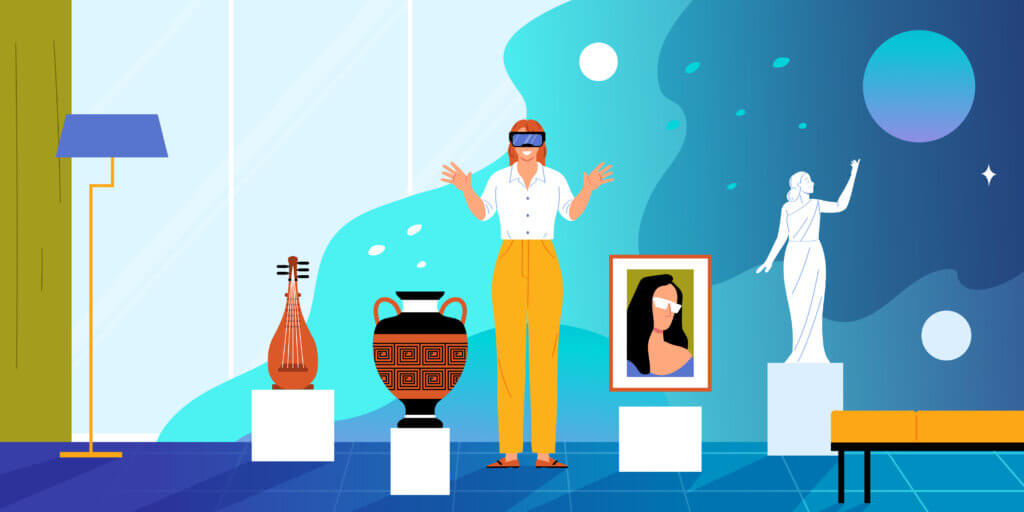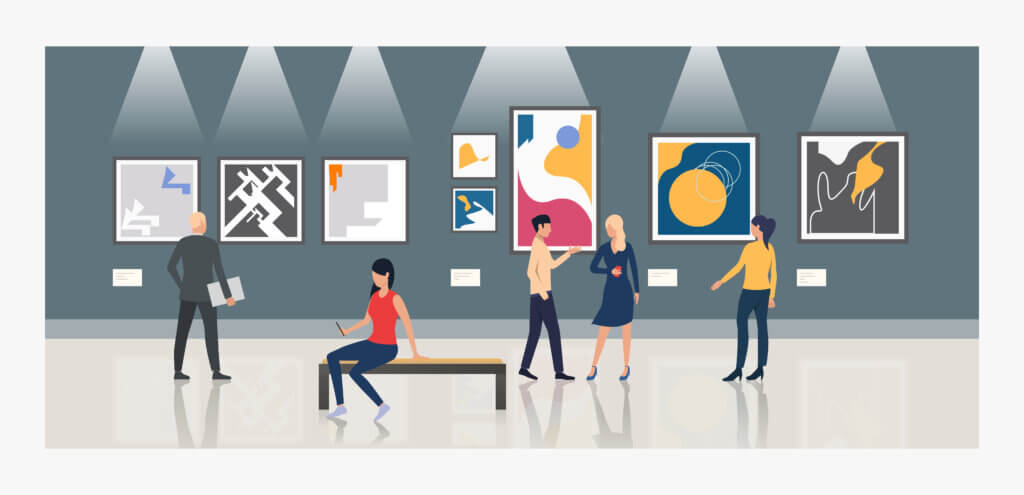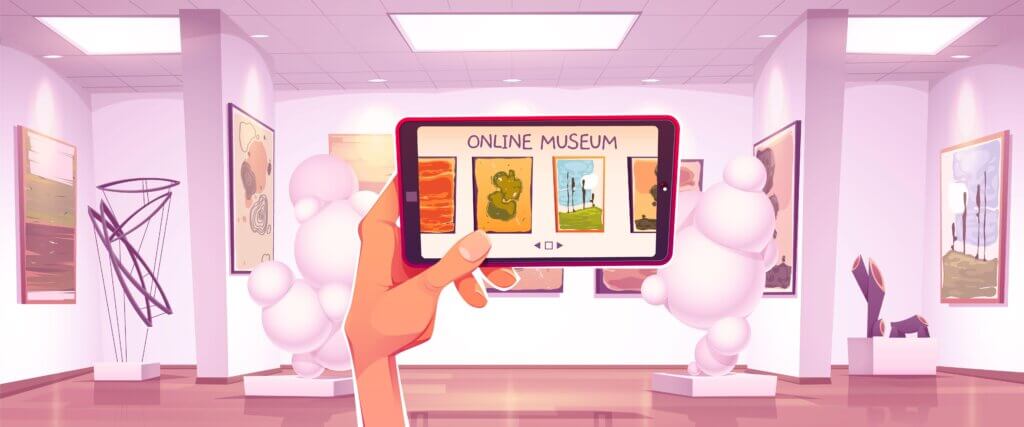
En 2025, le paysage muséal se réinvente, oscillant entre la préservation d’un héritage précieux et l’effervescence des innovations numériques. Impliquant plus qu’une simple modernisation technique, ce nouveau chapitre marque le dialogue entre les expériences toujours plus spectaculaires du monde du divertissement avec la conservation et la transmission du patrimoine culturel. Si le passage à l’ère numérique représente encore un véritable défi pour les musées, les opportunités apportées par les solutions sur mesure telles que les app builders no code qui permettent de créer une application sans code pour musée permettent pourtant de relever ce défi. Découvrez dans la suite de cet article comment la digitalisation des musées peut apporter des solutions sur mesure face à l’exigence d’évolution qu’impose l’ère numérique.
1. Le futur des musées : pourquoi la digitalisation est-elle la clé de leur succès en 2025 ?
« L’art est une aventure intérieure. Aujourd’hui, grâce à la technologie, cette aventure peut être partagée à une échelle jamais vue auparavant. » Jean-Michel Jarre, artiste pionnier de l’utilisation de la technologie dans la musique et les arts
La digitalisation des musées offre de nouvelles perspectives passionnantes. Élargissement de l’audience, enrichissement de l’expérience des visiteurs grâce à des contenus interactifs et personnalisés, redéfinition de la relation au patrimoine… autant de possibilités qui restaient impossibles à atteindre avant l’ère du numérique. En outre, la digitalisation favorise aussi l’amélioration de l’image des institutions et la création de nouvelles sources de revenus. Néanmoins, ce progrès ne peut se faire sans quelques contraintes.
Les jeunes : les cibles de la digitalisation des musées
Malgré les efforts pour attirer le public, la fréquentation des musées, notamment par les jeunes, montre des signes de déclin. L’offre culturelle, bien que diversifiée (gratuité, journées spéciales, expositions médiatisées), peine à capter l’attention d’un public plus habitué aux expériences rapides des réseaux sociaux. Ce phénomène révèle une mutation des usages, obligeant une communication mobile des musées plus pertinente, à repenser leur discours pour s’adapter aux attentes des jeunes générations. Pour y parvenir, ils doivent innover, surprendre et établir des collaborations originales, tout en élargissant leur cible pour inclure des catégories jusqu’alors marginalisées.
Souvent perçus comme difficiles à atteindre, les jeunes sont pourtant les visiteurs clés des musées de demain. Leur exigence se traduit par une attente de formats interactifs, ludiques et personnalisés, adaptés à leur mode de vie numérique. Leur immersion précoce dans le digital les rend particulièrement réceptifs aux expériences innovantes et stratégiques.
La digitalisation des grands musées et des plus petites structures culturelles

Contraintes et défis pour les petites structures
Si la digitalisation se présente comme une solution, elle ne se décline pourtant pas de la même manière selon les réalités institutionnelles. Pour les petites structures culturelles, les défis sont souvent d’ordre budgétaire et humain. Le développement d’une application mobile personnalisée, par exemple, peut coûter entre 10 000 et 50 000 euros, une somme qui dépasse parfois les moyens de ces musées aux budgets serrés. De surcroît, le manque de personnel spécialisé, qu’il s’agisse de webmasters, de chargés de communication digitale ou de producteurs multimédias peut freiner la mise en œuvre d’un projet numérique ambitieux.
Face à ces obstacles, de nombreuses institutions se tournent vers des solutions ingénieuses : les plateformes sans code, ou « app builders no code ». Il s’agit d’alternatives qui offrent la possibilité de créer une application en quelques clics, sans nécessiter de compétences en programmation. Parmi ces app builders no code, Apptree est présenté comme étant un modèle plus économique et plus accessible pour les musées, un outil leur offrant un moyen qui leur apporte une interface interactive et moderne, redéfinissant la manière dont ils dialoguent avec leurs publics. Créez une application de musée en un clic avec Apptree, l’outil no-code qui fait toute la différence !
Défis technologiques des grandes institutions
Si les grandes institutions bénéficient de ressources plus importantes, elles font néanmoins face à des défis complexes liés à la gestion de vastes collections, la sécurisation des données et l’intégration de technologies innovantes comme la réalité virtuelle. Les musées avec plus d’envergure doivent allier tradition et modernité pour offrir une expérience authentique et contemporaine.
L’utilisation de solutions sans code, comme les plateformes no-code, simplifie la gestion quotidienne des outils numériques. Ces solutions permettent aux équipes de mettre à jour et modifier les contenus en toute autonomie, offrant ainsi une réactivité accrue pour répondre aux exigences du moment tout en préservant l’authenticité de l’expérience muséale.
2. Les musées du futur : comment la technologie redéfinit-elle chaque visite ?

« L’accessibilité numérique permet d’élargir l’horizon de chaque musée, en offrant à tous une nouvelle manière de découvrir l’histoire et l’art. » Cécile Duflot, ancienne ministre et militante pour l’inclusion numérique.
Musées accessibles à tous : la technologie brise toutes les barrières !
L’accessibilité numérique est un levier clé pour démocratiser la culture. Grâce aux outils numériques, les personnes à mobilité réduite, les déficients sensoriels ou les publics étrangers peuvent désormais accéder facilement au patrimoine. La communication mobile des musées et les interfaces intelligentes transforment les musées en espaces inclusifs, offrant à tous une expérience culturelle sans barrières physiques.
Expérience visiteur immersive grâce aux technologies mobiles
Les innovations technologiques, notamment les applications mobiles, révolutionnent l’expérience des musées en offrant une immersion totale. Les visiteurs peuvent découvrir des œuvres via géolocalisation, télécharger des contenus enrichissants, et même acheter des billets en ligne. Les cartes interactives et parcours thématiques personnalisés permettent une exploration approfondie, transformant chaque visite en une aventure unique et captivante.
La magie de la réalité augmentée : redécouvrez les musées sous un angle inédit !
La réalité augmentée révolutionne l’expérience muséale en superposant des contenus virtuels à la réalité. Des musées renommés utilisent cette technologie pour offrir des visites immersives, permettant aux visiteurs de découvrir l’histoire d’une œuvre et de suivre les étapes de sa création. Par exemple, une exposition virtuelle permet aux spectateurs d’admirer des tableaux invisibles à l’œil nu. Ces innovations transforment le musée en un laboratoire d’expériences culturelles où l’histoire, l’émotion et la technologie se rencontrent. De plus, des outils comme créer une application sans coder pour musée facilitent la mise en place de telles expériences. Comment la digitalisation des musées redéfinit-elle l’expérience de visite, en intégrant des technologies immersives et éducatives ?
Médiation culturelle et transformation digitale
Ce qui était autrefois perçu comme une contrainte imposée pour séduire un public nouveau s’avère être une formidable opportunité. La médiation culturelle numérique, loin de se cantonner à un simple support technique, enrichit et dynamise la transmission du savoir. Elle transforme le musée en un lieu d’expériences multiples, où l’histoire se conjugue avec la modernité pour offrir à chacun un moment d’intense émotion.
3. Vous rêvez d’une app mobile pour votre musée ? Découvrez comment la créer sans coder !
62 % des visiteurs de musées préfèrent utiliser des applications mobiles pour explorer les expositions et accéder à des informations complémentaires (*1)
Désormais vous pouvez créer des applications mobiles sans coder une seule ligne de code. Avec notre App Builder Apptree, vous pouvez dépasser les barrières technologiques sans exploser votre budget. Avec Apptree, intégrer des contenus interactifs et multimédias (vidéos, animations, visites virtuelles) devient un jeu d’enfant, enrichissant l’expérience de vos visiteurs tout en maîtrisant vos coûts.
Cette approche agile vous encourage à expérimenter différentes stratégies de communication numérique, pour identifier ce qui résonne le mieux avec votre public. Grâce à Apptree, vous pouvez créer une application mobile entièrement personnalisée, parfaitement adaptée à l’identité de votre musée et aux besoins spécifiques de vos visiteurs. Que ce soit pour diffuser des informations en temps réel, offrir des parcours interactifs ou même faciliter l’achat de billets en ligne, Apptree simplifie chaque étape du processus.
De plus, en utilisant un app builder sans code, vous gagnez en flexibilité et réactivité, vous permettant de mettre à jour l’application en fonction des expositions en cours ou des événements à venir, sans avoir à faire appel à des développeurs. En créant une expérience fluide et engageante pour vos visiteurs, vous renforcez la relation avec votre public tout en augmentant la visibilité et l’attractivité de votre établissement.
L’accessibilité et la facilité d’utilisation d’Apptree permettent de donner vie à vos idées innovantes rapidement et sans contraintes techniques, de tester différentes fonctionnalités pour comprendre ce qui fonctionne le mieux et ajuster votre stratégie en continu pour maximiser l’impact de votre communication numérique.
Conclusion : comment la technologie redéfinit-elle le lien entre le passé et le futur ?
Dans ce vaste univers où se mêlent art, histoire et innovation, la technologie apparaît comme un trait d’union entre le passé et le futur. Elle permet aux œuvres de s’exprimer dans une langue nouvelle, celle de l’interactivité et de l’émotion, et offre aux visiteurs une expérience qui va bien au-delà de la simple contemplation. La digitalisation des musées devient ainsi un outil incontournable pour rendre l’art et l’histoire accessibles à un plus large public, et avec des solutions comme Apptree, il est désormais possible de créer une application sans coder pour musée, facilitant l’intégration de contenus interactifs tout en simplifiant le processus.
Source :
(1) : Part de Français ayant visité une exposition temporaire ou un musée au cours des douze derniers mois, selon les revenus/Statista.










